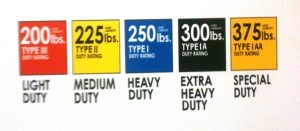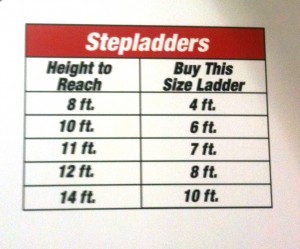We had a post in our forums with a question pertaining to ladders, so we thought it would be a good time to dig up one of our old article we wrote years ago and finally put it on toolsinaction.com. We also did an article a while back called Ladders – Safety and more. For this article we are going to talk about the types of ladders and get into a little more detail about some of the specifics. There are a lot of different types of ladders: extension ladders, step ladders, closet ladders and the list goes on. We are going to speak about ladders in a general sense and not necessarily talk about the difference between the type of ladders.
There are three primary materials used in ladders. You can buy a wood ladder, an aluminum ladder or a fiberglass ladder, yes there are more, but we are sticking to the most commonly available ladders. Back in the day wood was the material of choice for ladders and as advancements have come over the years, aluminum and fiberglass has taken over the wood ladder market, primarily because of cost and weight.
There are three primarily steps in buying and understanding ladders. For the three steps we are going to deal with step ladders.
Step 1– First figure out how high you need to reach or the maximum height you feel comfortable with. Will you need this to change light bulbs in the house? To get on your roof? If you have 12 foot ceiling and you will be using this ladder in the house only, you would need an 8ft ladder. There is a common chart as shown below which will guide you on what size to buy. Also don’t be afraid to set up a ladder in the store and see how it feels. This is not only a big monetary investment, but your life also depends upon buying a great ladder you feel comfortable on.
Step 2 – How much will the ladder be holding at anyone time. Figure out your weight and no you can not lie about your weight. You also need to figure out what items you want to hang off the ladder. If you are just painting, then a can of paint will not add that much to the overall weight limit of a ladder. On the other hand if you will be using this to carry up bags of cement, roofing materials or other heaving items, then you need to pay attention to the overall rating of the ladder. As you can see by the picture below, ladders have ratings with a weight rating. If you weight weight 300 lbs and are only going to paint the ceiling then you will have to have a Type 1AA. If weight only 100lbs wet and are going to paint, you can get away with a light duty or type 111 ladder.

Step 3– As with the question on the post what is the difference between a fiberglass and aluminum ladder. Well besides weight of the ladder and material of the ladder, the big difference is if you can work around electricity. As you may have guessed, if not please refer to the picture below, a fiberglass ladder does not conduct electrical current; therefore, you can use a fiberglass around electricity. If you will be doing small projects around the house and not dealing with electricity, an aluminum will work great as it is half the cost as fiberglass.

These are the three main key things you need to know about ladders. Don’t forget to check out our ladder safety and more article as it gets into safety and ladder jargon.
Note – Don’t forget to check out your ladder before you buy it. Look over the ladder to make sure there are no dents or parts missing. Believe it or not a small dent can weaken your ladder. Also never buy one of these cheaper ladders. Yes we know people are happy with them, but come on, this is your life. Sometimes gimmicks are best left at the carnivals, not in your home or one the job site.



The comment I would like to make is regarding extention ladders used for accessing roofs platforms and so forth.For safetey sake the top 4 rungs are left out so you can step through the ladder rather than around and have the potential of pushing the ladder over
Very good point.
Great information! it exceeds my expectations. Good Job.